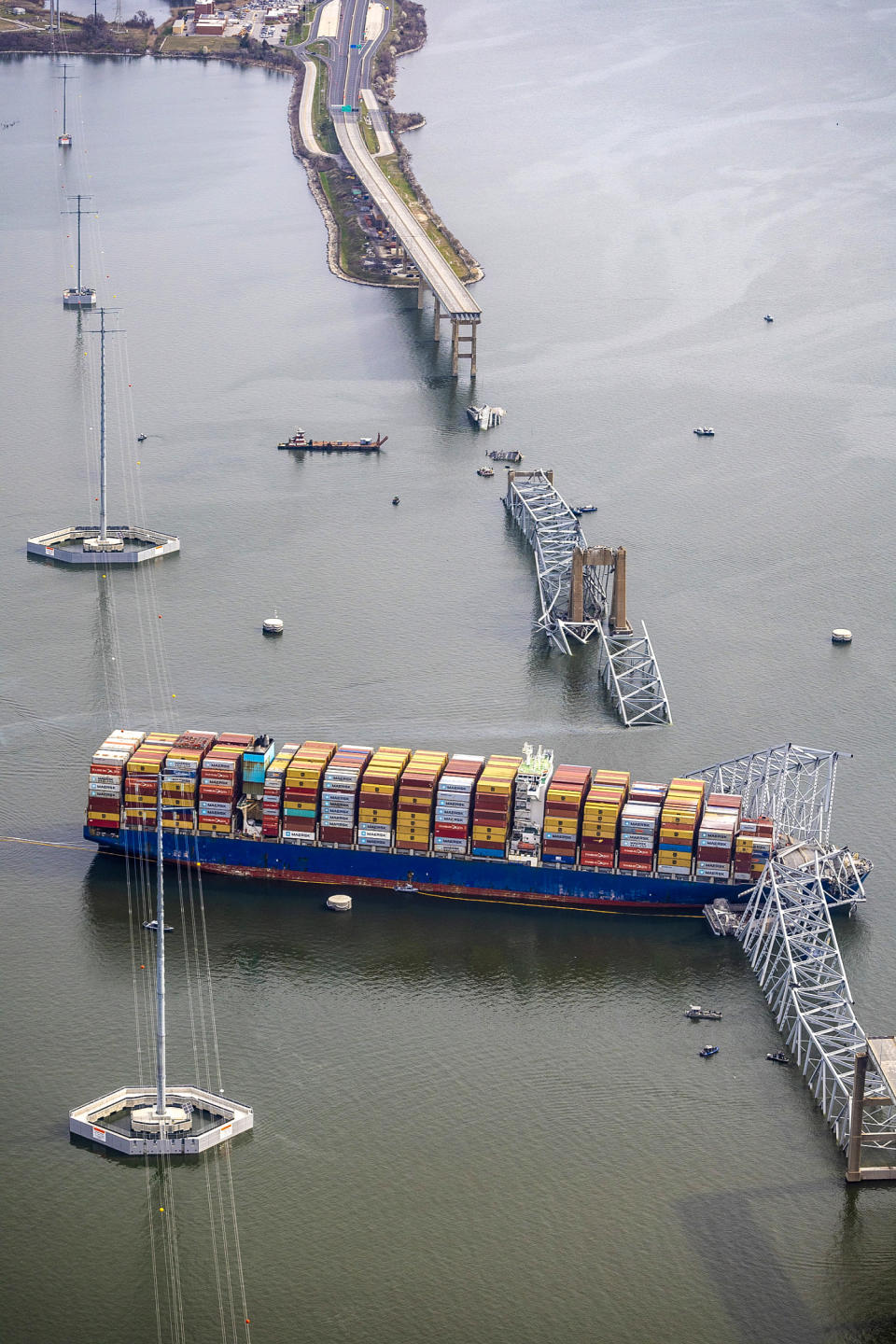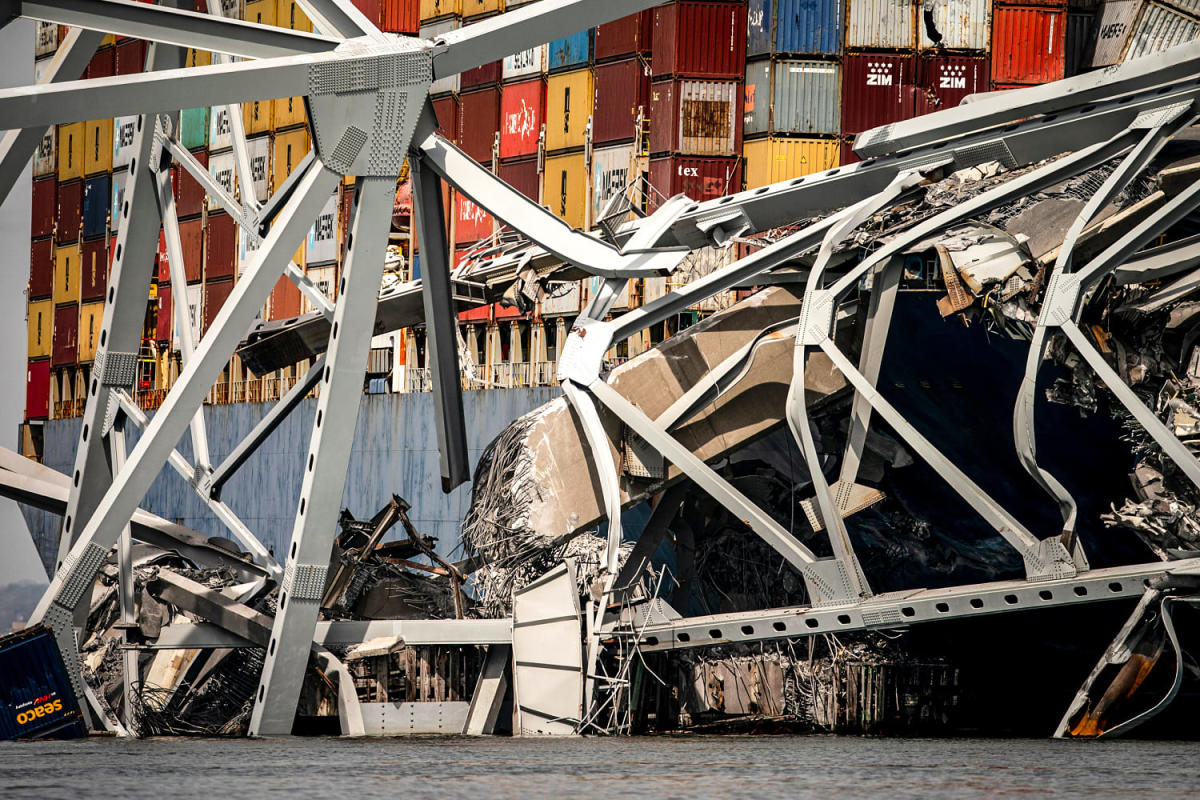“Bridges are and should be designed to withstand ship impacts. That’s typical of the design process,” said Sanjay R. Arwade, a professor of civil engineering at the University of Massachusetts Amherst.
“But for all structures and all engineered systems, there is a possibility that an event will occur that is beyond what the structure was designed for. And this may be one of those situations,” he added.
The Francis Scott Key Bridge, a roughly 1.5-mile-long steel arch truss bridge, collapsed into the Patapsco River early Tuesday after a containership struck it. Several vehicles crashed into the water, and one of the country’s busiest ports shut down.
An unknown number of workers with Brawner Builders Inc. were repairing concrete ducts when the ship, called the Dali, hit a support pillar. Six employees are presumed dead.
Key Bridge was ‘fairly unprotected’
Arwade said design codes for modern bridges stipulate “what sort of loads it has to be able to resist.”
“Whenever a design code is written, decisions have to be made about what the most extreme conditions are,” he said.
Maryland Gov. Wes Moore said the bridge was “fully up to code.”
But the Key Bridge was built in 1977, and bridge design and technology have improved since then.
“Since the 1970s, we have a lot of advancements,” Sameh Badie, a professor of engineering at George Washington University, told NBC Washington. But he said, “I saw today a couple of videos before the collapse, and it seems to me, structurally wise, it was very safe.”
Roberto Leon, a structural engineer at Virginia Tech, said that while engineers try to account for “extreme events” during the design and construction process, “when this bridge was built, there were no ships of this size.”
“This type of load was not really considered,” he said. “So the bridge was, I would say, fairly unprotected.”
Retrofitting older bridges could cost millions
Officials have not specified what type of protective infrastructure, if any, the Key Bridge had.
Leon said that on a newer bridge, large concrete structures called dolphins are often used to protect the base. Dolphins can form a kind of frame and are designed to take the impact of a vessel and “slow the ship down and redirect it away from the bridge,” he said.
“In some cases, they’re called sacrificial elements, because they might be damaged beyond repair if an event of this type occurs, but of course, they save the bridge,” he added.
John Pistorino, a structural engineer in Florida, said dolphins are in use to protect the Sunshine Skyway Bridge in Tampa, Florida, which was reopened in 1987, seven years after it was hit by a freighter. Thirty-five people died after the bridge collapsed into Tampa Bay.
Pistorino, who was involved in the construction of the rebuilt Sunshine Skyway Bridge, described dolphins as walls or guardrails.
“They can be concrete or steel … and they go all the way down to the bottom of the river,” he said. “They’re supposed to protect the abutments.”
Jacksonville, Florida, Mayor Donna Deegan cited the dolphin infrastructure that’s in place to protect the Dames Point Bridge — the only bridge in the city that cargo ships sail under — in a statement Tuesday. She noted that the bridge is also equipped with specialty sensors that provide real-time information about the distance between the water surface and the bottom of the bridge structure over the main channel.
Older and more vulnerable bridges can be retrofitted to add defensive infrastructure like dolphins, Leon said, but building them can cost hundreds of millions of dollars.
“I’m hoping that because of the infrastructure bill that passed, we are going to be able to do projects like this,” he said, referring to the $555 billion infrastructure bill that President Joe Biden signed in 2021. “Putting those into the budget and justifying them is very difficult when you have all kinds of other bridges that are in really sad shape. So it’s just a question of prioritization.”
However, Kevin Heaslip, director of the Center for Transportation Research and a professor of civil and environmental engineering at the University of Tennessee, Knoxville, said the cost of designing bridges to withstand fully loaded cargo ships like the Dali would “be so high that we wouldn’t be able to have any bridges.”

Government oversight of bridges could increase
Transportation Secretary Pete Buttigieg said he has been monitoring the situation in Baltimore. A team of investigators from the National Transportation Safety Board has been sent to the crash site.
Leon said he hopes what happened in Baltimore will cause port operations to change “quite a bit.” Pistorino said the event may lead legislators to take a closer look at vulnerable bridges in the country and the types of maritime traffic in ports.
“Just like the building collapse in South Florida created a lot of legislation that required a more intimate type of building scrutiny, I think that will happen on the bridges,” he said.
This article was originally published on NBCNews.com
